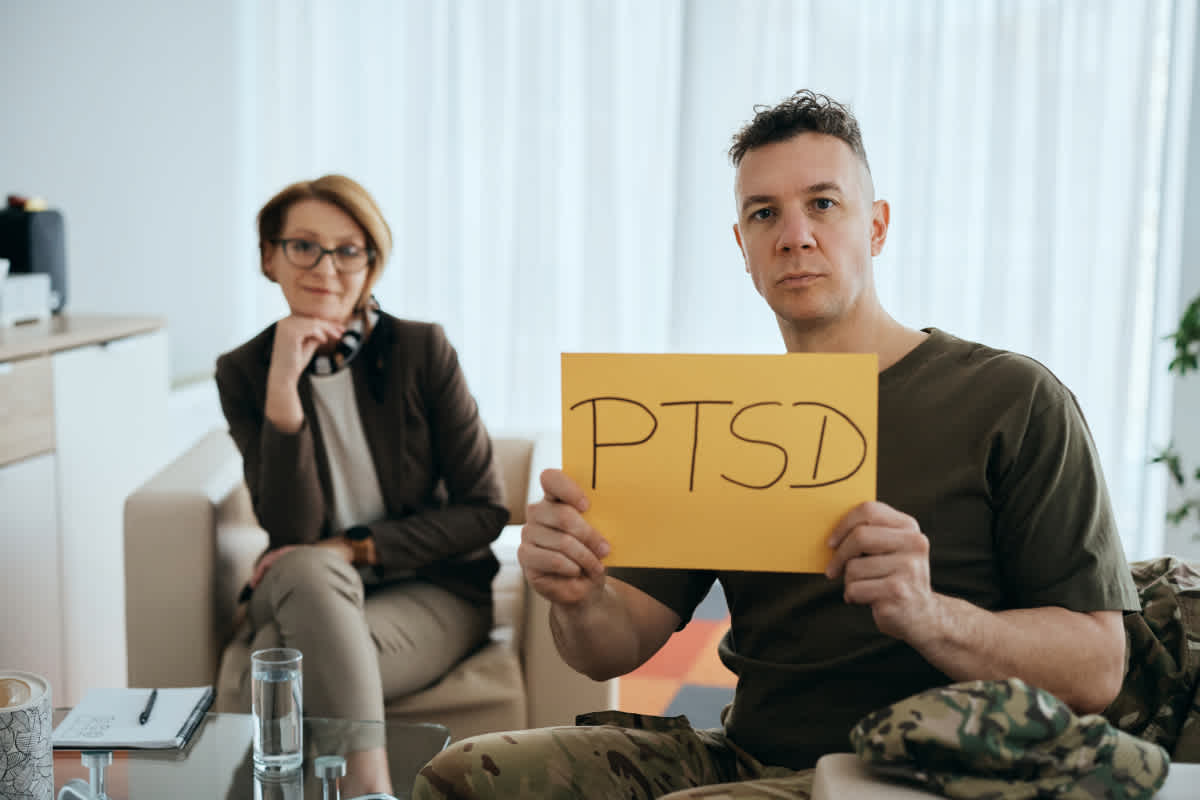What is Complex PTSD?

Most individuals will experience a traumatic experience at least once. Traumatic events often result in long-term psychological effects. It is often the result of overwhelming stress that exceeds one's ability to cope or integrate the emotions involved with that experience.
Chronic trauma can leave a person feeling helpless, confused, and alone. Trauma can also lead to post-traumatic stress disorder (PTSD), a condition where individuals relive the trauma through flashbacks, nightmares, or intrusive memories.
PTSD is often accompanied by anxiety, depression, and substance abuse. People who experience psychological trauma will recover with the help of family and friends. However, some people will develop long-term problems, which can develop into conditions like complex post-traumatic stress disorder.
C-PTSD is characterized by almost all the symptoms of PTSD and can result in more debilitating outcomes. Therefore, it is essential for one to deal with such events of chronic trauma with the cautiousness it deserves. The National Center for PTSD suggests that approximately 7 out of every 100 people will experience PTSD at some point.
Complex PTSD Test
Your results of this self-assessment are not a replacement for a professional diagnosis, nor is this test meant to be a proper diagnostic tool. Please use it only for educational purposes and talk to your doctor about all your symptoms.
What is C-PTSD?
Complex PTSD (C-PTSD) is a long-term condition that can develop after exposure to multiple traumatic events. It is also a "disorder of extreme stress not otherwise specified" (DESNOS).
Also, Complex PTSD is a more severe form of PTSD that can develop after prolonged, repeated exposure to trauma. It is characterized by more extensive symptoms than those seen in traditional PTSD. Complex PTSD can lead to significant impairment in social, occupational, and other vital areas of functioning.
Symptoms of Complex PTSD
According to World Health Organization, a complex PTSD diagnosis entails specific symptoms that indicate the existence of chronic PTSD. To be diagnosed with C-PTSD, individuals must have at least three of the following symptoms:
Re-Experiencing the Trauma Symptoms
These symptoms can entail nightmares and flashbacks, which are common in diagnosing PTSD. Often, such flashbacks and memories trigger negative emotions and make the individual feel like they are reliving the trauma. Also, it is not uncommon for individuals with C-PTSD to avoid any type of reminder or trigger of the trauma.
Avoidance Symptoms
Individuals with PTSD often attempt to avoid anything that might remind them of the traumatic event. This can include people, places, thoughts, and activities. People who have complex PTSD may also have trouble remembering aspects of the trauma which can also result in individual actions like drug abuse and self-medication. All this is to try and avoid recalling the incidents.
Heightened Threat Symptoms
There are persistent perceptions of high-level threat among individuals with complex PTSD. They are always on the lookout for danger even when there is none, which can make them feel agitated and cause them to lash out. This often leads to problems in work and personal relationships. The individual may also suffer from hypervigilance, insomnia, and an exaggerated startle response.
Additional symptoms include:
Emotional dysfunction
Negative self-perception
Disturbed relationships
Persistent feelings of sadness, shame, guilt, and worthlessness
Lack of trust
Problems with anger and impulsiveness
What Can Trigger Complex PTSD?
Several different experiences can trigger complex post-traumatic stress disorder (PTSD). Unlike PTSD, which typically develops after a single, isolated event, C-PTSD usually occurs after exposure to multiple or prolonged trauma.
This can include:
1. Childhood Trauma
Perhaps the most common cause is childhood trauma, such as physical or sexual abuse. Most individuals suffering from C-PTSD have endured childhood trauma of some kind. This is known to cause most chronic and long-term effects of complex PTSD since such trauma is hard to forget.
2. Domestic Violence
Prolonged exposure to domestic violence can also lead to C-PTSD, as it involves exposure to multiple traumas over an extended period. In most cases, the victims cannot leave the situation due to fear or other factors, which can further complicate matters. This leads to more distress and could ultimately lead to complex PTSD.
3. War
War can also lead to C-PTSD, as soldiers are often exposed to multiple ongoing traumatic events. This explains why veterans require special care and attention after they serve the nation.
4. Sexual Abuse, Kidnapping, Enslavement, or Torture
Any form of torture or prolonged exposure to sexual abuse can also lead to C-PTSD. These actions can cause emotional distress since the individuals are likely to replay events from the abuse and saddening memories.
5. Witnesses to Repeated Acts of Violence
Such individuals can also develop C-PTSD because they are constantly exposed to traumatic events. And may endure symptoms like flashbacks and nightmares related to the specific act of violence.
It is important to remember that not everyone who experiences these kinds of traumas will develop complex PTSD. Many factors contribute to the development of the disorder, including genetics, brain chemistry, and previous trauma. Individuals experiencing these traumas should seek professional help to deal with the aftermath.
What is the Difference Between Complex and Regular PTSD?
Trauma can have a profound effect on mental health, and those who have experienced traumatic events may go on to develop post-traumatic stress disorder (PTSD). In general, there are two types of PTSD: complex PTSD and regular PTSD. Both types share many of the same symptoms, such as flashbacks, nightmares, and avoidance of triggers. However, there are some key differences between the two.
Complex PTSD is a condition that can develop in people who have experienced prolonged or repeated trauma. Unlike regular PTSD, which typically results from a single, catastrophic event, complex PTSD is often the result of ongoing exposure to difficult circumstances, such as child abuse, domestic violence, or war. As a result, people with complex PTSD often struggle with various symptoms, including flashbacks, nightmares, trouble sleeping, and difficulty trusting others. They may also have problems with impulsivity, self-harm, and substance abuse.
While complex PTSD is not yet recognized as a separate disorder in the Diagnostic and Statistical Manual of Mental Disorders (DSM-5), it is increasingly recognized as a distinct condition with unique symptoms. However, people with complex PTSD can recover and live healthy, fulfilling lives with proper diagnosis and treatment.
Disorders Similar to Complex PTSD
In addition to complex PTSD, several other disorders share similar symptoms.
1. Disorders of Extreme Stress Not Otherwise Specified (DESNOS)
DESNOS is often used interchangeably with complex PTSD, particularly in the United States. Like complex PTSD, DESNOS is characterized by a history of trauma and a cluster of symptoms, including dissociation, identity disturbance, and impulsivity. However, it is essential to note that DESNOS is not currently recognized as a separate disorder in the DSM-5.
2. Borderline Personality Disorder (BPD)
Borderline Personality Disorder (BPD) shares similarities with complex PTSD. Similar symptoms characterize both disorders, but BPD does not necessitate a history of trauma. Instead, some researchers believe that genetics or brain function could be the main cause of BPD. However, other authorities consider complex PTSD a subtype of BPD, but others think they're two different conditions.
3. Acute Stress Disorder
Acute stress disorder (ASD) is a mental health condition that can occur after a traumatic event. Like post-traumatic stress disorder (PTSD), ASD is marked by symptoms of anxiety, flashbacks, and avoidance behaviors. However, ASD typically develops within four weeks of the trauma, while PTSD may not develop until months or even years later.
ASD is also more likely to occur in individuals who have experienced multiple traumas or have preexisting mental health conditions. While ASD and PTSD share many similarities, the two disorders are distinct and require different treatment approaches.
Because of the overlap in symptoms, it can be challenging to diagnose these disorders accurately. However, receiving an accurate diagnosis is essential to get the most effective treatment based on the evident symptoms, among other reasons.
Treatment for Complex PTSD
1. Talk Therapy
Talking therapy for Complex PTSD can include evidence-based therapies known to help individuals deal with chronic trauma. There are several types of talking treatment that can be effective for PTSD, including:
Trauma-focused cognitive behavioral therapy (TF-CBT): This is a form of cognitive behavioral therapy that has been specifically adapted for PTSD. TF-CBT usually involves 8-12 regular sessions, seeing the same therapist at least once a week. This therapy helps people to process and make sense of their traumatic experiences. It educates individuals on how to manage their symptoms.
Eye movement desensitization and reprocessing (EMDR): A specialized therapy approach for trauma processing.
Cognitive Processing Therapy (CPT): Another evidence-based approach for trauma recovery.
2. Medication
Some people with complex PTSD may benefit from medications to help with specific symptoms. For example, antidepressants can be used to help with depression and anxiety, while antipsychotics can be used to help with hallucinations or delusions.
While PTSD is not the same as depression, antidepressants may be helpful for people with complex PTSD who also struggle with depression. Also, since it could be associated with sleep loss, most used medications are meant to ease symptoms. It's essential to work with a psychiatrist or other mental health professional to find the proper medication or combination of medications.
3. Exposure Therapy
Exposure therapy is a type of treatment that can help patients gradually confront their trauma and learn to manage their symptoms. Different types of exposure therapy can be used to treat Complex PTSD.
Group therapy, art therapy, and play therapy are all effective methods for helping patients to confront their trauma and learn how to deal with it healthily. Each type of exposure therapy has its benefits, and the best treatment plan will likely involve a combination of different approaches.
Self-Care For Coping With Complex PTSD
Post-traumatic stress disorder can adversely affect a person's mental and physical health and ability to undertake daily activities. Here are some self-care tips for coping with complex PTSD:
1. Know the Triggers
Be aware of what triggers the symptoms and try to avoid them where possible. If avoiding the triggers is a problem, have a plan in place for how to deal with them. Some of the most common triggers can easily remind individuals of the trauma. They include smell, places, and stains, among others.
2. Have a Support System
Individuals with complex PTSD should have someone to talk to about what they are going through. This could be a friend, family member, therapist, or support group. Trying to hide trauma can worsen the symptoms. A strong support system can help individuals through tough times.
3. Try Peer Support
There are often groups available for people with complex PTSD. These can provide practical and emotional support. Also, peer support ensures that one is not alone and can share their troubles with people going through similar issues. This can help them accept reality and eventually help them move on.
4. Have Patience
Every individual is different in terms of how they are affected by trauma and response. Recovery from complex PTSD can take time. Complex PTSD should be patient with themselves and don't expect miracles overnight. Being patient and taking time helps heal both physically and mentally.
5. Prioritize Self-Care
It's essential to look after physical health when dealing with complex PTSD. Some of the things one can do to take care of themselves include:
Eat a healthy diet
Exercise regularly
Get enough sleep
Avoid alcohol and drug abuse
Seek specialist support
If the C-PTSD symptoms are severe or one is struggling to cope, it's essential to seek professional help from a therapist or counselor specializing in treating complex PTSD.
Find Specialized Treatment for Complex PTSD and Trauma
Complex PTSD requires specialized, trauma-informed treatment that addresses both the symptoms and underlying trauma. Use our comprehensive treatment directory to find qualified mental health providers who specialize in complex PTSD and understand the unique challenges of prolonged trauma exposure. Our directory connects you with professionals experienced in trauma-informed care, evidence-based therapies like EMDR and trauma-focused CBT, and comprehensive treatment approaches designed to help you process trauma, develop healthy coping strategies, and build a foundation for lasting recovery and healing.
Sources
International Classification of Diseases 11th Revision. (2022, February). ICD-11 for Mortality and Morbidity Statistics. Retrieved from https://icd.who.int/browse11/l-m/en#/http%253a%252f%252fid.who.int%252ficd%252fentity%252f2070699808
PTSD: National Center for PTSD. https://www.ptsd.va.gov/professional/treat/essentials/complex_ptsd.asp
American Psychiatric Association. 2013. Diagnostic and Statistical Manual of Mental Disorders, Fifth edition. (DSM-5). https://www.psychiatry.org/file%20library/psychiatrists/practice/dsm/apa_dsm-5-ptsd.pdf
Resick, P. A., Suvak, M. K., Johnides, B. D., Mitchell, K. S., & Iverson, K. M. (2012). The impact of dissociation on PTSD treatment with Cognitive Processing Therapy. Depression & Anxiety, 29. 718-730. doi:10.1002/da.21938
Department of Veterans Affairs and Department of Defense. (2017). VA/DOD clinical practice guideline for the management of post-traumatic stress disorder and acute stress disorder. Washington DC: Author. Retrieved from: www.healthquality.va.gov/guidelines/MH/ptsd/
Friedman, M. J. (2013). Finalizing PTSD in DSM-5: Getting here from there and where to go next. Journal of Traumatic Stress, 26, 548-556. doi:10.1002/jts21840
World Health Organization. (2019, April). ICD-11 for Mortality and Morbidity Statistics. Retrieved from: https://icd.who.int/browse11/l-m/en
Locate Treatment Centers Near You
Enter your location to discover facilities offering the care and support you need in your area.


